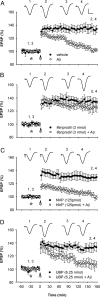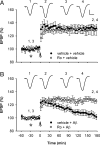GluN2B subunit-containing NMDA receptor antagonists prevent Abeta-mediated synaptic plasticity disruption in vivo
- PMID: 19918059
- PMCID: PMC2787128
- DOI: 10.1073/pnas.0908083106
GluN2B subunit-containing NMDA receptor antagonists prevent Abeta-mediated synaptic plasticity disruption in vivo
Erratum in
- Proc Natl Acad Sci U S A. 2010 Jul 13;107(28):12734. Anwy, Roger [corrected to Anwyl, Roger]
Abstract
Currently, treatment with the relatively low-affinity NMDA receptor antagonist memantine provides limited benefit in Alzheimer's disease (AD). One probable dose-limiting factor in the use of memantine is the inhibition of NMDA receptor-dependent synaptic plasticity mechanisms believed to underlie certain forms of memory. Moreover, amyloid-beta protein (Abeta) oligomers that are implicated in causing the cognitive deficits of AD potently inhibit this form of plasticity. Here we examined if subtype-preferring NMDA receptor antagonists could preferentially protect against the inhibition of NMDA receptor-dependent plasticity of excitatory synaptic transmission by Abeta in the hippocampus in vivo. Using doses that did not affect control plasticity, antagonists selective for NMDA receptors containing GluN2B but not other GluN2 subunits prevented Abeta(1-42) -mediated inhibition of plasticity. Evidence that the proinflammatory cytokine TNFalpha mediates this deleterious action of Ass was provided by the ability of TNFalpha antagonists to prevent Abeta(1-42) inhibition of plasticity and the abrogation of a similar disruptive effect of TNFalpha using a GluN2B-selective antagonist. Moreover, at nearby synapses that were resistant to the inhibitory effect of TNFalpha, Abeta(1-42) did not significantly affect plasticity. These findings suggest that preferentially targeting GluN2B subunit-containing NMDARs may provide an effective means of preventing cognitive deficits in early Alzheimer's disease.
Conflict of interest statement
The authors declare no conflict of interest.
Figures





Similar articles
-
Neurotransmitter receptor and time dependence of the synaptic plasticity disrupting actions of Alzheimer's disease Aβ in vivo.Philos Trans R Soc Lond B Biol Sci. 2013 Dec 2;369(1633):20130147. doi: 10.1098/rstb.2013.0147. Print 2014 Jan 5. Philos Trans R Soc Lond B Biol Sci. 2013. PMID: 24298149 Free PMC article.
-
Therapeutic significance of NR2B-containing NMDA receptors and mGluR5 metabotropic glutamate receptors in mediating the synaptotoxic effects of β-amyloid oligomers on long-term potentiation (LTP) in murine hippocampal slices.Neuropharmacology. 2011 May;60(6):982-90. doi: 10.1016/j.neuropharm.2011.01.051. Epub 2011 Feb 12. Neuropharmacology. 2011. PMID: 21310164
-
Amyloid beta peptide 1-42 disturbs intracellular calcium homeostasis through activation of GluN2B-containing N-methyl-d-aspartate receptors in cortical cultures.Cell Calcium. 2012 Feb;51(2):95-106. doi: 10.1016/j.ceca.2011.11.008. Epub 2011 Dec 15. Cell Calcium. 2012. PMID: 22177709
-
Alzheimer's disease, β-amyloid, glutamate, NMDA receptors and memantine--searching for the connections.Br J Pharmacol. 2012 Sep;167(2):324-52. doi: 10.1111/j.1476-5381.2012.02057.x. Br J Pharmacol. 2012. PMID: 22646481 Free PMC article. Review.
-
The neuropharmacological basis for the use of memantine in the treatment of Alzheimer's disease.CNS Drug Rev. 2003 Fall;9(3):275-308. doi: 10.1111/j.1527-3458.2003.tb00254.x. CNS Drug Rev. 2003. PMID: 14530799 Free PMC article. Review.
Cited by
-
Calmodulin Binding Proteins and Alzheimer's Disease: Biomarkers, Regulatory Enzymes and Receptors That Are Regulated by Calmodulin.Int J Mol Sci. 2020 Oct 5;21(19):7344. doi: 10.3390/ijms21197344. Int J Mol Sci. 2020. PMID: 33027906 Free PMC article. Review.
-
Soluble Aβ Oligomers Impair Dipolar Heterodendritic Plasticity by Activation of mGluR in the Hippocampal CA1 Region.iScience. 2018 Aug 31;6:138-150. doi: 10.1016/j.isci.2018.07.018. Epub 2018 Jul 24. iScience. 2018. PMID: 30240608 Free PMC article.
-
Synaptic GluN2A-Containing NMDA Receptors: From Physiology to Pathological Synaptic Plasticity.Int J Mol Sci. 2020 Feb 24;21(4):1538. doi: 10.3390/ijms21041538. Int J Mol Sci. 2020. PMID: 32102377 Free PMC article. Review.
-
Neurotransmitter receptor and time dependence of the synaptic plasticity disrupting actions of Alzheimer's disease Aβ in vivo.Philos Trans R Soc Lond B Biol Sci. 2013 Dec 2;369(1633):20130147. doi: 10.1098/rstb.2013.0147. Print 2014 Jan 5. Philos Trans R Soc Lond B Biol Sci. 2013. PMID: 24298149 Free PMC article.
-
Dysfunction of NMDA receptors in Alzheimer's disease.Neurol Sci. 2016 Jul;37(7):1039-47. doi: 10.1007/s10072-016-2546-5. Epub 2016 Mar 12. Neurol Sci. 2016. PMID: 26971324 Free PMC article. Review.
References
-
- Hynd MR, Scott HL, Dodd PR. Glutamate-mediated excitotoxicity and neurodegeneration in Alzheimer's disease. Neurochem Int. 2004;45:583–595. - PubMed
-
- Haass C, Selkoe DJ. Soluble protein oligomers in neurodegeneration: Lessons from the Alzheimer's amyloid beta-peptide. Nat Rev Mol Cell Biol. 2007;8:101–112. - PubMed
-
- Raina P, et al. Effectiveness of cholinesterase inhibitors and memantine for treating dementia: Evidence review for a clinical practice guideline. Ann Intern Med. 2008;148:379–397. - PubMed
Publication types
MeSH terms
Substances
LinkOut - more resources
Full Text Sources
Other Literature Sources
Medical
Miscellaneous

